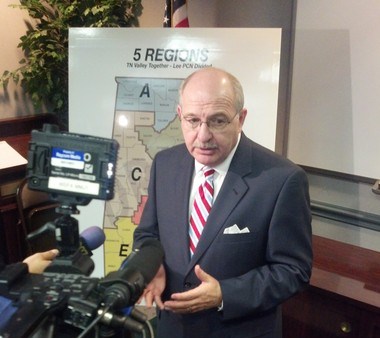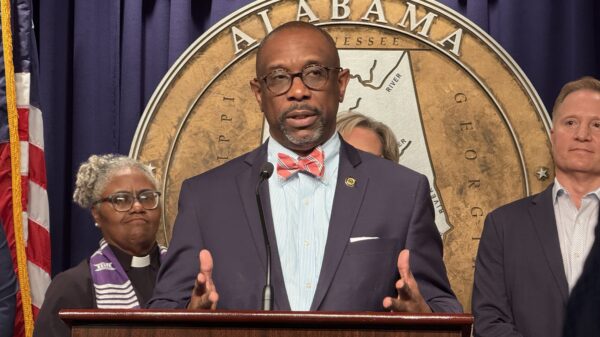By Brandon Moseley
Alabama Political Reporter
MONTGOMERY—On Monday, Alabama Medicaid announced that the state of Alabama will have five Regional Care Organizations (RCOs) rather than the seven many people had expected.
As part of the landmark Medicaid reform legislation passed by the Alabama Legislature and signed into law by the governor the state Medicaid program is being redesigned from a Provider Fee For Service model to a regional managed care model. The state will transfer the responsibility for the program from the state to five Regional Care Organizations who will bear the liability of the program and provide the services for Alabama’s poorest residents.
The North Alabama RCO (RCO A on the map) will consist of Limestone, Madison, Morgan, Lauderdale, Colbert, Franklin, Lawrence, Marshall, Jackson, and Cullman Counties. When this was being debated in the Capital some hospitals in northwest Alabama had wanted their own Northwest RCO. Instead the Shoals area will be in the same region as Huntsville, Decatur, Cullman, and Boaz. 120,039 Medicaid beneficiaries live in the North Alabama Region costing Medicaid $413 million in fiscal year 2012.
The East Alabama (RCO B) will consist of Dekalb, Cherokee, Etowah, Calhoun, Cleburne, Randolph, Tallapoosa, Coosa, Clay,Talladega, Blount, St. Clair, Shelby, Walker, and Jefferson Counties. The Cities of Birmingham, Hoover, Bessemer, Anniston, Gadsden, Jasper, Moody, Pelham, Mountain Brook, Heflin, Talladega, and Alexander City will be in this populous region. 214,153 Medicaid beneficiaries currently live in this region and $867 million was spent by Medicaid in this region in 2012.
The West Alabama RCO (RCO C) will consist of Winston, Marion, Fayette, Lamar, Pickens, Greene, Sumter, Choctaw, Marengo, Perry, Hale, Bibb, and Tuscaloosa Counties. Tuscaloosa, Northport, Winfield, Hamilton, Demopolis, and Livingston are among the cities found in this region. Only 61,534 Medicaid clients live in this, the smallest population of the regions. Providing care to these beneficiaries cost $224 million.
South East/Central Alabama (RCO D)will include Houston, Geneva, Barbour, Coffee, Dale, Henry, Butler, Crenshaw, Pike, Bullock, Russell, Chambers, Lee, Macon, Elmore, Dallas, Wilcox, Lowndes, Autauga, Chilton, and Montgomery Counties. Montgomery, Prattville, Auburn, Troy, Dothan, Selma, Clanton, and Enterprise are among the cities in this region. 172,518 Medicaid beneficiaries live in this area making it the second largest of the RCOs in terms of population costing $586 million.
Many observers had expected that the seventh RCO would have been South East Alabama consisting of Dothan and the surrounding area.
The South West Alabama region (RCO E) consists of Covington, Escambia, Conecuh, Monroe, Clarke, Washington, Baldwin, and Mobile Counties. 116,670 Medicaid recipients reside in this region costing Medicaid $420 million.
There will be only one RCO operating per region. The Medicaid beneficiary’s residence will determine which regional RCO regional that they are assigned to. Any willing provider applies not only within region, but also across regional lines. For example, physicians and hospitals will be able to contract within their region as well as with adjacent regions.
A large hospital like the University of Alabama Hospital in Birmingham gets Medicaid patients from its own Jefferson County in RCO B. But it also gets them as well as some from close by counties like Tuscaloosa in RCO C, Cullman in RCO A, and Chilton in RCO D. It is possible then that that hospital and many of the specialists who work there may contract with multiple RCOs.
Alabama Medicaid will establish a floor for applicable provider payments for all regions, including out-of-region contracts. The RCOs will attempt to negotiate prices with providers as close to the floor as possible in order to control costs, although Medicaid providers are likely to make up most of the RCO’s governing boards.
Medicaid also provided a time line on Monday. The RCO regions will be set by October 1, 2013. The RCO governing boards are to be set and approved by Medicaid by October 1, 2014. The RCO provider networks have to be in place by April 1, 2015. All five of the RCOs must meet solvency requirements by October 1, 2015. By October 1, 2016 the RCOs will accept capitation payments from Medicaid.
Long-term care is not being addressed by the RCOs. Reforming how Alabama delivers long-term care for the indigent is a future goal of the Alabama legislature that likely won’t be addressed until after the 2014 election.
Medicaid reform has been predicted to save the state over $50 million a year.




















































